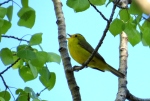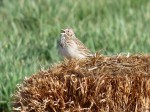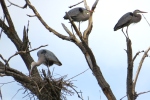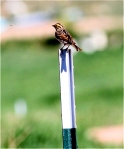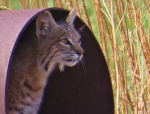It is 4:30am and dark outside my open bedroom window. A Robin is singing its familiar sing-song morning wake-up call. Like all songbirds they only sing during a short season, so I lie awake and enjoy the ephemeral treat.
Songbirds, or properly the Order of birds known as Passeriformes, make up over half of the roughly 10,000 bird species now known worldwide. They are a large and unwieldy group with the odd unifying characteristic of three toes pointing forward and one backward, helping them to perch on branches.
What has made them so endearing to humanity is the ability of many of these songbirds to sing elaborate songs. In the temperate zone where I live in Colorado, they do so during a relatively short season, stretching from April-July with prime-time being May and June. Male songbirds (mostly it is the males who sing) sing to announce territories which they defend from other males while inviting females to breed. Once the nesting season ends, so does the time of bird song.
Visit a mountain lake, a prairie grassland, or a suburban backyard anywhere across the country and you can be sure to find a unique soundscape made up of that area’s singing birds. Listen as males from neighboring territories joust back and forth in extended singing duels. Learn the songs and you are entering a world of secret language, drama and intrigue.
A great resource to explore birds and their songs is the Cornell Lab of Ornithology’s “All About Birds” website: http://www.allaboutbirds.org/guide/search.aspx This site not only provides a variety of background info and pictures of North American birds but also has recordings you can listen to of each species’ distinctive songs, calls and other vocalizations.
Author: dbrudin
The Snake Den
Depending on who you are, finding a snake den can be the stuff of nightmares or the find of a lifetime. I, of course, fall into the latter category. As a child I grew up in the hilly forests of Western Pennsylvania, at the north end of the Appalachian Mountains. My friends and I were always on the lookout for Box Turtles, Garter Snakes, Salamanders and a rare find would be a Black Rat Snake, like the 5 footer which showed up on my suburban front lawn one summer day.
I can remember my father, suite coat over his shoulder on this steamy day, telling me to not leave my snakes laying around in the yard. I had no idea what he was talking about until he pointed out in the front yard to inform me that there was a huge black snake in our front yard. I didn’t even let him finish his sentence before I was out the front door like a shot. There it was, the holy grail of childhood snakes, gleaming black and trying to get into the bushes. I grabbed him by the tail, maneuvered him into the middle of the yard and after getting a pretty good bite, leaving a horseshoe of tiny pin pricks of blood, I had him under control. Up the street I ran to show my friend Tommy Gallagher my find. But in all those years, I never found a snake den.
Fast forward to November 2014, hiking in Garden of the Gods near my current home. Two garter snakes are basking on an unseasonably warm day. I’d never seen them out this late, and was amazed by the enormous size of one of the snakes, surely a female. When they saw me, they slithered away under a huge boulder. Bingo! No snake would be out basking at this time of year without having their den close by. I remember seeing a rattlesnake in this vicinity last year and it is common for mixed species to share a den, the place where they will hibernate through the winter.
Dozens of snakes might share a den as the conditions they need to survive a winter are not always easy to find. Whether it is amongst rocks or in a rodent den, snakes need to get below the frost line to survive a northern winter. It is theorized that by sharing a den, they also help keep the environment more humid through their respiration and thus dehydrate more slowly.
This spring my vigilance in visiting the den repeatedly paid off with a sighting of two tiny, first year rattlesnakes, basking outside the den. Born live last fall, the two were tiny but fully armed with fangs and venom. Both were very close to entrances so they could beat a hasty retreat if need be. Snakes will disperse in the spring, sometimes a couple of miles distant, before returning in the fall. They are key predators, keeping rodent populations in check. Despite their sinister reputation they much prefer not being discovered and will rattle only to warn when they feel a person or animal is too close.
Prairie Rattlesnakes are found throughout the midwest and western US and from northern Mexico to southern Canada. They are members of the Viper Family and have sophisticated sensory adaptations to help them hunt small mammals, like their heat seeking pits.
To learn more about these fascinating creatures, check out the book: Amphibians and Reptiles in Colorado, by Geoffrey Hammerson, the bible of Colorado herping (herpetology is the study of reptiles and amphibians).
Birds, Migration and Weather
The first annual Pikes Peak Birding and Nature Festival is in the books. Besides learning about the complexities of organizing such a multi-faceted event, I also learned a little about how weather affects bird migration.
I’ll skip any attempt here to dive into meteorology for the simple reason that I know only the basics. What is undeniable though, is that cold and unsettled weather impacts bird migration dramatically.
Every spring, billions of birds engage in the largest movement of land animals on the planet. My ringside seat for this event is a small farm, just south of Colorado Springs, Venetucci Farm/Pinello Ranch. These 500 acres border Fountain Creek and are in the middle of a migration corridor. Most of the 198 species of birds seen there are migrants.
This year’s combination of rain, hail and cold halted the progress of many of these migrants resulting in incredible numbers of species. On both May 9 & 10 we saw over 70 species of birds at Pinello Ranch. Other trips to area hotspots, like Lake Pueblo, Big Johnson Reservoir and others posted incredible totals of 98 and even 124 bird species, for one far ranging outing.
What is clear is that birds operate on the slimmest of margins and many don’t survive migration. Enough do to give a survival advantage to those who migrate. With survival on the line, weather plays a huge role in bird migration patterns. For an in depth treatment of the timing of migration, check out this amazing site from the Cornell Lab of Ornithology: http://birdcast.info/forecasts/
The Fragile Birth of a Heronry
Venetucci Farm’s and Pinello Ranch’s wild corners continue to yield surprises as we work to tell the evolving story of these community treasures. The latest discovery, by volunteer Gloria Nikolai, is of a Great Blue Heron Rookery. These nesting colonies, properly called a Heronry, are often times built in dead trees and almost always near wetlands or ponds. Adjacent to the heronry, a pond now exists in a wooded section of Venetucci Farm thanks to the efforts of some industrious beavers. Natural springs flow through Pinello Ranch creating two large ponds and a mosaic of wetland habitat before reaching the beaver pond and then flowing into Fountain Creek.
As the spring flow is seasonal, one of the challenges we face is keeping water in the system when the spring stops flowing, usually mid-summer into fall. Last year the beaver pond completely dried up as did cattail sloughs and even portions of the larger ponds at Pinello. The ponds, sloughs and wetlands are at the core of the incredibly productive wildlife habitat at Venetucci/Pinello.
For over 40 years the ponds had been kept going by filling them with irrigation water. Now that it has been determined that that violates water law, we are scrambling to find ways in which we can keep the water flowing. At Venetucci Farm we seek to provide healthy food and connect people to the source of that food. We strive to produce that food “in a way that conserves, protects, and restores the natural environment”, as we state in our mission statement.
Keeping the flow of water going is one way in which we honor our mission. It means allowing beavers, herons and a host of other creatures to continue to thrive right on the edge of the city. We seek to share this story of how wildlife and agriculture can exist synergistically, through our education programs. It is one more amazing facet of the ever-changing and unique community assets known as Venetucci Farm and Pinello Ranch.
Birds on a Wire
I am fascinated by how animals adapt to a changing world. In particular, how do wild animals utilize human-altered habitat and man-made structures. To be sure, many species are too reclusive or their habitat requirements are too specific to be found in human altered landscapes.
I have a whole series of bird photos I might loosely refer to as “Birds on a Wire”. Birds readily utilize poles, fences, wires etc… as perches. This is especially true in grasslands, natural or man-made, as these perches offer a place to survey their surroundings. Even a slight elevation can help males proclaim their territories, free from the muffling influence of ground vegetation.
Birds are not the only creatures to take advantage of human alterations to landscapes. In 2010, while hiking through King’s Canyon near Tucson, I came across an old stone shelter. The roof had blown off and a few yards away lay the tar paper. The ground underneath was shaded and damp. Besides the usual invertebrates, a brightly colored lizard caught my eye. It was a Western Banded Gecko. These native geckos are primarily nocturnal and this one had appropriated the tar paper as a daytime refuge.
What started this whole train of thought is a series of large pipes and culverts stored by Colorado Springs Utilities at Pinello Ranch. They provide a favorite hiding place for cottontail rabbits and once I saw a bullsnake slither away under them. Last week our Ranch Manager, Patrick, pointed out two bobcats hunting amongst the pipes, most likely for those rabbits. These wary cats are not usually out and about during the day. I wondered if the two might work in tandem, trapping a rabbit somewhere in the maze of pipes.
Roughly 2/3 of the continental US is being used for agricultural production. Given this massive use of land to raise our food, it is clear that farms and ranches need to also provide wildlife habitat. Not only is it a necessity to conserve wildlife, but it is also smart for farmers and ranchers. This is a complex theme that I will return to again and again.
Old Man Coyote
Perhaps no animal has been more vilified and yet revered than Canis latrans, known most commonly as the coyote. On the one hand persecuted by farmers and ranchers, Old Man Coyote also plays the role of trickster and sometimes hero in many Native American stories.
While coyotes have made enemies primarily by preying on livestock, they have also moved into the suburban and urban world and in some cases become accustomed to people with incidents of aggression towards pets and humans. However, they also are a boon to farmers by hunting agricultural pests like rodents and rabbits. At Venetucci Farm, like at most farms, we have our share of rodents helping themselves to our crops. In fact, the concentration of food sources that results from agriculture, also concentrates crop pests…and thus their predators.
The key in living with the predators is making the farm’s livestock off limits which encourages coyotes to hunt wild prey. So to Fight Fire with Fire, we use a domestic dog to fight a wild dog.
Enter Lewis and Clark
Venetucci Farm is home to two Great Pyrenees and their role is predator deterrent. While lovable with people, these are large, formidable dogs and very territorial. So by deploying Lewis and Clark and locking up vulnerable livestock at night we protect the farm’s animals while benefiting from coyotes’ pest control services.
There is another dynamic at play. As top predators, coyotes keep in check foxes, raccoons and stray cats. This is an example of a trophic cascade, one trophic level (level in the food chain) affecting those below. In a classic study, Michael Soule, widely known as the father of Conservation Biology, studied bird populations in the canyons outside of San Diego. It turned out that canyons with coyotes had more birds, and less bird predators.
Birds are key ecosystem players. Keeping insect populations in check is one key role, especially important to farmers. For an urban farm like Venetucci, stray cats would normally be a present in large numbers but they are virtually non-existent while bird populations flourish.
Thus Old Man Coyote, the mythological trickster and sometimes hero, has parallels with coyote, the wild dog of North America. In both cases his roles are many and complex, his success in adapting and surviving is unequivocal and his future presence in the world a certainty. As humans have altered the natural world, we are finding out how complex natural systems are and once they are disturbed, what a challenging task it is to restore balance.
Vacation Post- South Florida
Greetings to all from sunny Florida! For a Naturalist, Florida is a land of contrasts: incredible wildlife and sprawling, habitat destroying, development. Winter bird feeders can have gorgeous visitors like this Painted Bunting
Invasive species on the other hand are a big problem, as this link on the latest research on Burmese Pythons in the Everglades explains: http://www.miamiherald.com/news/local/environment/article15399467.html
During my time here I visited local nature centers, restored wetlands (Green Cay and Wakodahatchee), wildlife management areas and I even went down to the Dry Tortugas, 70 miles west of Key West, for several days. Below are a few of the highlights. Soon it will be time to head back to Colorado and recalibrate to a spring that is just arriving.
Butterflies, Turtles and Ducks, Oh My!
March 15, 2015: A visit to Section 16 today turned up lots of butterflies. Mourning Cloaks and a few smaller orange butterflies. From a review of field guides they look like some type of Anglewing. Both of these butterflies overwinter as adults and thus can begin their mating and egg laying early in the spring. Mourning Cloaks are large, dark butterflies with yellow trim to their wings. They have the advantage of being easy to identify. I watched two fly straight up, circling one another as they went. The Anglewings are smaller, orange-colored with black spots and jagged edges to their wings. I’m adding an image from Pinello Ranch of one that looks very much like today’s Section 16 butterflies.
March 12, 2015: Hiking around Pinello Ranch today plenty of duck action including: Cinnamon Teal, Wood Ducks (pictured from a previous visit), Northern Shovelers, Green-winged Teal and even a pair of Common Goldeneye. The shovelers and goldeneyes will leave us soon while we hope the Wood Ducks stay and nest. A half dozen painted turtles also hauled themselves out to bask on the shoreline of Painted Turtle Pond. These turtles are just rousing themselves from months of winter hibernation under the ice of the ranch ponds.
Welcome!
Welcome All! I try to get out every day and explore some corner of the natural world, wherever I happen to be. I am fortunate to be the Education Coordinator at Venetucci Farm and Pinello Ranch (www.venetuccifarm.org) near Colorado Springs, CO. This old farm gives me even more areas to explore and document. As part of that exploration, I jot down what I consider noteworthy sightings, experiences and reflections in my journal. I want to share a select few of these in this blog and to begin a dialogue with anyone who wants to join this journey through the seasons.
One Swallow does not a Summer Make
March 10, 2015: Tree Swallow sighted at Venetucci Farm near a wild little corner we call “Coyote Willows”. It was circling around a nesting box that has been used by Tree Swallows in past years. True to its name, two adult coyotes were seen while exploring Coyote Willows. 
For the last few days farm fields at Venetucci have played host to a small flock of Mountain Bluebirds. They alternate between foraging in the fields and sitting on fence posts. These smallish members of the thrush family (relatives of the robin) pass through each spring on their way to higher elevations.

